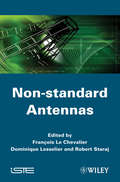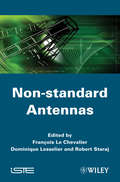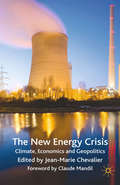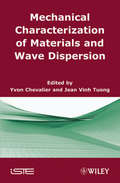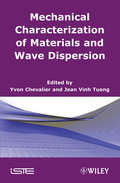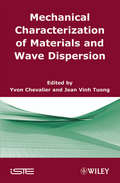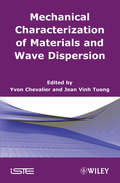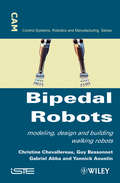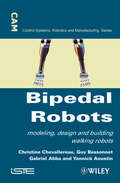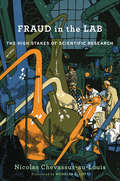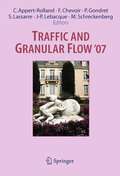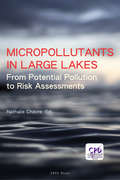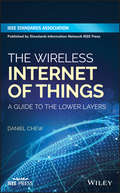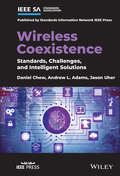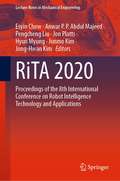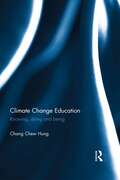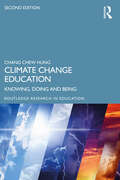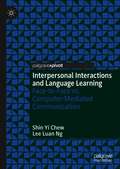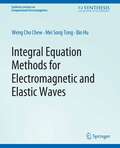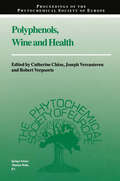- Table View
- List View
Non-standard Antennas
by François Le Chevalier Dominique Lesselier Robert StarajThis book aims at describing the wide variety of new technologies and concepts of non-standard antenna systems – reconfigurable, integrated, terahertz, deformable, ultra-wideband, using metamaterials, or MEMS, etc, and how they open the way to a wide range of applications, from personal security and communications to multifunction radars and towed sonars, or satellite navigation systems, with space-time diversity on transmit and receive. A reference book for designers in this lively scientific community linking antenna experts and signal processing engineers.
Non-standard Antennas
by François Le Chevalier Dominique Lesselier Robert StarajThis book aims at describing the wide variety of new technologies and concepts of non-standard antenna systems – reconfigurable, integrated, terahertz, deformable, ultra-wideband, using metamaterials, or MEMS, etc, and how they open the way to a wide range of applications, from personal security and communications to multifunction radars and towed sonars, or satellite navigation systems, with space-time diversity on transmit and receive. A reference book for designers in this lively scientific community linking antenna experts and signal processing engineers.
The New Energy Crisis: Climate, Economics and Geopolitics
by J. ChevalierThe New Energy Crisis comes from the recent intrusion of climate change issues into energy economics and geopolitics. Global warming reveals that the current evolution of the world energy consumption is on an unsustainable path. This book explores economic and geopolitical tensions and reinforces ways to overcome the crisis.
Mechanical Characterization of Materials and Wave Dispersion: Instrumentation and Experiment Interpretation
by Yvon Chevalier Jean Vinh TuongOver the last 50 years, the methods of investigating dynamic properties have resulted in significant advances. This book explores dynamic testing, the methods used, and the experiments performed, placing a particular emphasis on the context of bounded medium elastodynamics. Dynamic tests have proven to be as efficient as static tests and are often easier to use at lower frequency. The discussion is divided into four parts. Part A focuses on the complements of continuum mechanics. Part B concerns the various types of rod vibrations: extensional, bending, and torsional. Part C is devoted to mechanical and electronic instrumentation, and guidelines for which experimental set-up should be used are given. Part D concentrates on experiments and experimental interpretations of elastic or viscolelastic moduli. In addition, several chapters contain practical examples alongside theoretical discussion to facilitate the readers understanding. The results presented are the culmination of over 30 years of research by the authors and as such will be of great interest to anyone involved in this field.
Mechanical Characterization of Materials and Wave Dispersion
by Yvon Chevalier Jean Vinh TuongDynamic tests have proven to be as efficient as static tests and are often easier to use at lower frequency. Over the last 50 years, the methods of investigating dynamic properties have resulted in significant advances. This book explores dynamic testing, the methods used, and the experiments performed, placing a particular emphasis on the context of bounded medium elastodynamics. The discussion is divided into four parts. Part A focuses on the complements of continuum mechanics. Part B concerns the various types of rod vibrations: extensional, bending, and torsional. Part C is devoted to mechanical and electronic instrumentation, and guidelines for which experimental set-up should be used are given. Part D concentrates on experiments and experimental interpretations of elastic or viscolelastic moduli. In addition, several chapters contain practical examples alongside theoretical discussion to facilitate the reader?s understanding. The results presented are the culmination of over 30 years of research by the authors and as such will be of great interest to anyone involved in this field.
Mechanical Characterization of Materials and Wave Dispersion: Instrumentation and Experiment Interpretation
by Yvon Chevalier Jean Tuong VinhOver the last 50 years, the methods of investigating dynamic properties have resulted in significant advances. This book explores dynamic testing, the methods used, and the experiments performed, placing a particular emphasis on the context of bounded medium elastodynamics. Dynamic tests have proven to be as efficient as static tests and are often easier to use at lower frequency. The discussion is divided into four parts. Part A focuses on the complements of continuum mechanics. Part B concerns the various types of rod vibrations: extensional, bending, and torsional. Part C is devoted to mechanical and electronic instrumentation, and guidelines for which experimental set-up should be used are given. Part D concentrates on experiments and experimental interpretations of elastic or viscolelastic moduli. In addition, several chapters contain practical examples alongside theoretical discussion to facilitate the readers understanding. The results presented are the culmination of over 30 years of research by the authors and as such will be of great interest to anyone involved in this field.
Mechanical Characterization of Materials and Wave Dispersion
by Yvon Chevalier Jean Tuong VinhDynamic tests have proven to be as efficient as static tests and are often easier to use at lower frequency. Over the last 50 years, the methods of investigating dynamic properties have resulted in significant advances. This book explores dynamic testing, the methods used, and the experiments performed, placing a particular emphasis on the context of bounded medium elastodynamics. The discussion is divided into four parts. Part A focuses on the complements of continuum mechanics. Part B concerns the various types of rod vibrations: extensional, bending, and torsional. Part C is devoted to mechanical and electronic instrumentation, and guidelines for which experimental set-up should be used are given. Part D concentrates on experiments and experimental interpretations of elastic or viscolelastic moduli. In addition, several chapters contain practical examples alongside theoretical discussion to facilitate the reader?s understanding. The results presented are the culmination of over 30 years of research by the authors and as such will be of great interest to anyone involved in this field.
Bipedal Robots: Modeling, Design and Walking Synthesis
by Christine Chevallereau Gabriel Abba Yannick Aoustin Guy BessonnetThis book presents various techniques to carry out the gait modeling, the gait patterns synthesis, and the control of biped robots. Some general information on the human walking, a presentation of the current experimental biped robots, and the application of walking bipeds are given. The modeling is based on the decomposition on a walking step into different sub-phases depending on the way each foot stands into contact on the ground. The robot design is dealt with according to the mass repartition and the choice of the actuators. Different ways to generate walking patterns are considered, such as passive walking and gait synthesis performed using optimization technique. Control based on the robot modeling, neural network methods, or intuitive approaches are presented. The unilaterality of contact is dealt with using on-line adaptation of the desired motion.
Bipedal Robots: Modeling, Design and Walking Synthesis (Iste Ser. #28)
by Christine Chevallereau Guy Bessonnet Gabriel Abba Yannick AoustinThis book presents various techniques to carry out the gait modeling, the gait patterns synthesis, and the control of biped robots. Some general information on the human walking, a presentation of the current experimental biped robots, and the application of walking bipeds are given. The modeling is based on the decomposition on a walking step into different sub-phases depending on the way each foot stands into contact on the ground. The robot design is dealt with according to the mass repartition and the choice of the actuators. Different ways to generate walking patterns are considered, such as passive walking and gait synthesis performed using optimization technique. Control based on the robot modeling, neural network methods, or intuitive approaches are presented. The unilaterality of contact is dealt with using on-line adaptation of the desired motion.
Fraud in the Lab: The High Stakes of Scientific Research
by Nicolas Chevassus-au-LouisFrom manipulated results and fake data to retouched illustrations and plagiarism, cases of scientific fraud have skyrocketed in the past two decades. In a damning exposé, Nicolas Chevassus-au-Louis details the circumstances enabling the decline in scientific standards and highlights efforts to curtail future misconduct.
Traffic and Granular Flow ' 07
by François Chevoir Philippe Gondret Sylvain Lassarre Jean-Patrick Lebacque Michael Schreckenberg Cécile Appert-RollandMicropollutants in Large Lakes: From Potential Pollution Sources to Risk Assessments
by Nathalie ChevreScientists, regulators, and the general public are now more and more aware of the chemicals present in surface waters worldwide. Agrochemicals, such as herbicides or insecticides, pharmaceuticals and cosmetics can be detected at low to medium concentrations in seas, groundwaters and rivers. Among freshwaters, lakes are of particular concern. These large reservoirs are used as sources of food and drinking water, but also serve for recreational activities. This book aims in presenting insights into the physical, chemical, and ecological dynamics of large lakes that enable proposing recommendations for sustainable lake management regarding chemicals. Lake Geneva, Switzerland, is used as a case study, but the developed methodologies and tools can be useful for lake water quality management in general. A first chapter is dedicated to the chemicals entering the lake through agriculture. These are mainly pesticides. After a review of the different types of compounds, the authors present the main pathways these compounds follow to enter the lake. The case of glyphosate, an herbicide largely used worldwide, is presented. A second chapter illustrates the urban source of pollutants with the case of pharmaceuticals and biocides. Two models are presented that allow estimating the load and the dynamic of these chemicals that may exit from an urban catchment and therefore reach a lake. Special attention will be paid to the ‘end of pipe’ removal of these compounds at a WWTP. A third chapter is dedicated to the lake circulation. The aim of this chapter is to present an overall description of the lake’s hydrodynamics, which is driven by three factors: wind, temperature and Coriolis forces. To achieve this aim, a hydrodynamic model is presented that allows describing the behavior of the top layer of the lake based on the wind direction. The importance of stable hydrogen and oxygen isotopes for characterizing the sources of water and the mixing processes in the lake is also described. The next chapters are dedicated to a Bay, called the Vidy Bay, that receives the treated effluents of the largest wastewater treatment plant of the lake catchment. This latter represents therefore one of the major point sources of contaminants for lake Geneva. These two chapters will focus on the various processes that control the transfer of chemicals (associated to particles or in a dissolved state) discharged into the bay and transported to the lake’s main water body. Then, a next chapter focuses on one major issue of chemicals in aquatic systems like lakes, i.e. the risk of the mixture of chemicals. The evaluation of the risk of mixture is not trivial and the models that allow doing it are presented in a critical way. Their validity as predictive tools is illustrated with the example of herbicides mixture in Lake Geneva. A final chapter synthesizes the main findings and discusses some recommendations for the management of large lakes regarding micropollution.
Micropollutants in Large Lakes: From Potential Pollution Sources to Risk Assessments
by Nathalie ChevreScientists, regulators, and the general public are now more and more aware of the chemicals present in surface waters worldwide. Agrochemicals, such as herbicides or insecticides, pharmaceuticals and cosmetics can be detected at low to medium concentrations in seas, groundwaters and rivers. Among freshwaters, lakes are of particular concern. These large reservoirs are used as sources of food and drinking water, but also serve for recreational activities. This book aims in presenting insights into the physical, chemical, and ecological dynamics of large lakes that enable proposing recommendations for sustainable lake management regarding chemicals. Lake Geneva, Switzerland, is used as a case study, but the developed methodologies and tools can be useful for lake water quality management in general. A first chapter is dedicated to the chemicals entering the lake through agriculture. These are mainly pesticides. After a review of the different types of compounds, the authors present the main pathways these compounds follow to enter the lake. The case of glyphosate, an herbicide largely used worldwide, is presented. A second chapter illustrates the urban source of pollutants with the case of pharmaceuticals and biocides. Two models are presented that allow estimating the load and the dynamic of these chemicals that may exit from an urban catchment and therefore reach a lake. Special attention will be paid to the ‘end of pipe’ removal of these compounds at a WWTP. A third chapter is dedicated to the lake circulation. The aim of this chapter is to present an overall description of the lake’s hydrodynamics, which is driven by three factors: wind, temperature and Coriolis forces. To achieve this aim, a hydrodynamic model is presented that allows describing the behavior of the top layer of the lake based on the wind direction. The importance of stable hydrogen and oxygen isotopes for characterizing the sources of water and the mixing processes in the lake is also described. The next chapters are dedicated to a Bay, called the Vidy Bay, that receives the treated effluents of the largest wastewater treatment plant of the lake catchment. This latter represents therefore one of the major point sources of contaminants for lake Geneva. These two chapters will focus on the various processes that control the transfer of chemicals (associated to particles or in a dissolved state) discharged into the bay and transported to the lake’s main water body. Then, a next chapter focuses on one major issue of chemicals in aquatic systems like lakes, i.e. the risk of the mixture of chemicals. The evaluation of the risk of mixture is not trivial and the models that allow doing it are presented in a critical way. Their validity as predictive tools is illustrated with the example of herbicides mixture in Lake Geneva. A final chapter synthesizes the main findings and discusses some recommendations for the management of large lakes regarding micropollution.
The Wireless Internet of Things: A Guide to the Lower Layers
by Daniel ChewProvides a detailed analysis of the standards and technologies enabling applications for the wireless Internet of Things The Wireless Internet of Things: A Guide to the Lower Layers presents a practitioner’s perspective toward the Internet of Things (IoT) focusing on over-the-air interfaces used by applications such as home automation, sensor networks, smart grid, and healthcare. The author—a noted expert in the field—examines IoT as a protocol-stack detailing the physical layer of the wireless links, as both a radio and a modem, and the media access control (MAC) that enables communication in congested bands. Focusing on low-power wireless personal area networks (WPANs) the text outlines the physical and MAC layer standards used by ZigBee, Bluetooth LE, Z-Wave, and Thread. The text deconstructs these standards and provides background including relevant communication theory, modulation schemes, and access methods. The author includes a discussion on Wi-Fi and gateways, and explores their role in IoT. He introduces radio topologies used in software-defined radio implementations for the WPANs. The book also discusses channel modelling and link budget analysis for WPANs in IoT. This important text: Introduces IEEE 802.15.4, ITU-T G.9959, and Bluetooth LE as physical layer technology standards enabling wireless IoT Takes a layered approach in order to cultivate an appreciation for the various standards that enable interoperability Provides clarity on wireless standards with particular focus on actual implementation Written for IoT application and platform developers as well as digital signal processing, network, and wireless communication engineers; The Wireless Internet of Things: A Guide to the Lower Layersoffers an inclusive overview of the complex field of wireless IoT, exploring its beneficial applications that are proliferating in a variety of industries.
The Wireless Internet of Things: A Guide to the Lower Layers
by Daniel ChewProvides a detailed analysis of the standards and technologies enabling applications for the wireless Internet of Things The Wireless Internet of Things: A Guide to the Lower Layers presents a practitioner’s perspective toward the Internet of Things (IoT) focusing on over-the-air interfaces used by applications such as home automation, sensor networks, smart grid, and healthcare. The author—a noted expert in the field—examines IoT as a protocol-stack detailing the physical layer of the wireless links, as both a radio and a modem, and the media access control (MAC) that enables communication in congested bands. Focusing on low-power wireless personal area networks (WPANs) the text outlines the physical and MAC layer standards used by ZigBee, Bluetooth LE, Z-Wave, and Thread. The text deconstructs these standards and provides background including relevant communication theory, modulation schemes, and access methods. The author includes a discussion on Wi-Fi and gateways, and explores their role in IoT. He introduces radio topologies used in software-defined radio implementations for the WPANs. The book also discusses channel modelling and link budget analysis for WPANs in IoT. This important text: Introduces IEEE 802.15.4, ITU-T G.9959, and Bluetooth LE as physical layer technology standards enabling wireless IoT Takes a layered approach in order to cultivate an appreciation for the various standards that enable interoperability Provides clarity on wireless standards with particular focus on actual implementation Written for IoT application and platform developers as well as digital signal processing, network, and wireless communication engineers; The Wireless Internet of Things: A Guide to the Lower Layersoffers an inclusive overview of the complex field of wireless IoT, exploring its beneficial applications that are proliferating in a variety of industries.
Wireless Coexistence: Standards, Challenges, and Intelligent Solutions
by Daniel Chew Andrew L. Adams Jason UherWireless Coexistence Explore a comprehensive review of the motivation for wireless coexistence and the standards and technology used to achieve it Wireless Coexistence: Standards, Challenges, and Intelligent Solutions delivers a thorough exploration of wireless ecosystems sharing the spectrum, including the multiple standards and key requirements driving the current state of wireless technology. The book surveys several standards, including IEEE 802.22, 802.15.2, and 802.19.1 and expands upon recent advances in machine learning and artificial intelligence to demonstrate how these technologies might be used to meet or exceed the challenges of wireless coexistence. The text discusses cognitive radio in the context of spectrum coexistence and provides a comparison and assessment of using artificial intelligence in place of, or in addition to, current techniques. It also considers applications to communication theory, learning algorithms for passive wireless coexistence strategies, spectrum situational awareness, and active wireless coexistence strategies. With the necessity of spectrum sharing and the scarcity of unused spectrum on the rise, the standardization of wireless coexistence becomes more important with each passing day. Readers will learn about the challenges posed by shrinking wireless real estate and from the inclusion of topics like: A thorough introduction to the concept of, and motivation for, wireless coexistence, including congestion and interference, policies, and regulations An exploration of different wireless coexistence standards, including the need for standardization and various protocols, including 802.22, 802.15.2, 802.19.1, P1900, and 3GPP Release 13/14 LAA A discussion of the applications of communication theory, including primary user strategies, primary multi-user protocols, and successive interference cancellation A treatment of concepts in learning algorithms Perfect for scientists, researchers, engineers, developers, educators, and administrators working in the area of wireless networks, Wireless Coexistence: Standards, Challenges, and Intelligent Solutions will also earn a place in the libraries of graduate students studying wireless networks and seeking a one-stop reference for subjects related to wireless coexistence standards.
Wireless Coexistence: Standards, Challenges, and Intelligent Solutions
by Daniel Chew Andrew L. Adams Jason UherWireless Coexistence Explore a comprehensive review of the motivation for wireless coexistence and the standards and technology used to achieve it Wireless Coexistence: Standards, Challenges, and Intelligent Solutions delivers a thorough exploration of wireless ecosystems sharing the spectrum, including the multiple standards and key requirements driving the current state of wireless technology. The book surveys several standards, including IEEE 802.22, 802.15.2, and 802.19.1 and expands upon recent advances in machine learning and artificial intelligence to demonstrate how these technologies might be used to meet or exceed the challenges of wireless coexistence. The text discusses cognitive radio in the context of spectrum coexistence and provides a comparison and assessment of using artificial intelligence in place of, or in addition to, current techniques. It also considers applications to communication theory, learning algorithms for passive wireless coexistence strategies, spectrum situational awareness, and active wireless coexistence strategies. With the necessity of spectrum sharing and the scarcity of unused spectrum on the rise, the standardization of wireless coexistence becomes more important with each passing day. Readers will learn about the challenges posed by shrinking wireless real estate and from the inclusion of topics like: A thorough introduction to the concept of, and motivation for, wireless coexistence, including congestion and interference, policies, and regulations An exploration of different wireless coexistence standards, including the need for standardization and various protocols, including 802.22, 802.15.2, 802.19.1, P1900, and 3GPP Release 13/14 LAA A discussion of the applications of communication theory, including primary user strategies, primary multi-user protocols, and successive interference cancellation A treatment of concepts in learning algorithms Perfect for scientists, researchers, engineers, developers, educators, and administrators working in the area of wireless networks, Wireless Coexistence: Standards, Challenges, and Intelligent Solutions will also earn a place in the libraries of graduate students studying wireless networks and seeking a one-stop reference for subjects related to wireless coexistence standards.
RiTA 2020: Proceedings of the 8th International Conference on Robot Intelligence Technology and Applications (Lecture Notes in Mechanical Engineering)
by Esyin Chew Anwar P. P. Abdul Majeed Pengcheng Liu Jon Platts Hyun Myung Junmo Kim Jong-Hwan KimThis book gathers the Proceedings of the 8th International Conference on Robot Intelligence Technology and Applications (RITA 2020). The areas covered include: Instrumentation and Control, Automation, Autonomous Systems, Biomechatronics and Rehabilitation Engineering, Intelligent Systems, Machine Learning, Mobile Robotics, Social Robotics and Humanoid Robotics, Sensors and Actuators, and Machine Vision, as well as Signal and Image Processing. As a valuable asset, the book offers researchers and practitioners a timely overview of the latest advances in robot intelligence technology and its applications.
Climate Change Education: Knowing, doing and being
by Chang Chew HungClimate change is a controversial topic; some people assert that climate change is not occurring, and others believe that reports are inaccurate, that whilst climate change is happening, it may not be caused by human activity. There are also climate alarmists who use IPCC reports to support their claims that erratic weather patterns are a result of climate change caused by human activity. Regardless of these different viewpoints, one fact can be agreed upon; climate change is a complex subject and there is a need to educate future generations, enabling them to deal with the plethora of information and views that they will experience in their lives. This book explores what education for climate change entails, discussing the concept of Climate Change Education (CCE) itself, how it can be taught in schools and how public education can be carried out. It instructs what specific subject matter to teach for CCE, and how to evaluate the student learning on the subject. Chapters include: CCE in the Formal Curriculum Teacher readiness for CCE Assessment for and of CCE Lessons from CCE for Public Education Climate Change Education is an extremely useful resource for anyone involved in educating students on climate change and also for those interested in climate change itself.
Climate Change Education: Knowing, doing and being
by Chang Chew HungClimate change is a controversial topic; some people assert that climate change is not occurring, and others believe that reports are inaccurate, that whilst climate change is happening, it may not be caused by human activity. There are also climate alarmists who use IPCC reports to support their claims that erratic weather patterns are a result of climate change caused by human activity. Regardless of these different viewpoints, one fact can be agreed upon; climate change is a complex subject and there is a need to educate future generations, enabling them to deal with the plethora of information and views that they will experience in their lives. This book explores what education for climate change entails, discussing the concept of Climate Change Education (CCE) itself, how it can be taught in schools and how public education can be carried out. It instructs what specific subject matter to teach for CCE, and how to evaluate the student learning on the subject. Chapters include: CCE in the Formal Curriculum Teacher readiness for CCE Assessment for and of CCE Lessons from CCE for Public Education Climate Change Education is an extremely useful resource for anyone involved in educating students on climate change and also for those interested in climate change itself.
Climate Change Education: Knowing, Doing and Being (Routledge Research in Education)
by Chang Chew HungClimate change is complex and there is a need to educate our future generations so that they are able to deal with the plethora of information and views that they come into contact with in their lives. This book inquires into what it means to teach and learn about climate change. Now in its second edition, Chang further explores what education for climate change entails, discussing the concept of climate change education (CCE) itself, how it is taught in schools and how public education is being carried out. Featuring updated literature in a quickly advancing field, the book defines CCE for the global citizen and looks at pedagogies supporting CCE. It also identifies teachers as key stakeholders in climate change discourse, how to improve teacher readiness on the topic and how teacher professional development can support successful implementation of CCE. This book will be invaluable to climate change educators and can act as a reference resource for teachers, education policymakers and public education agencies.
Climate Change Education: Knowing, Doing and Being (Routledge Research in Education)
by Chang Chew HungClimate change is complex and there is a need to educate our future generations so that they are able to deal with the plethora of information and views that they come into contact with in their lives. This book inquires into what it means to teach and learn about climate change. Now in its second edition, Chang further explores what education for climate change entails, discussing the concept of climate change education (CCE) itself, how it is taught in schools and how public education is being carried out. Featuring updated literature in a quickly advancing field, the book defines CCE for the global citizen and looks at pedagogies supporting CCE. It also identifies teachers as key stakeholders in climate change discourse, how to improve teacher readiness on the topic and how teacher professional development can support successful implementation of CCE. This book will be invaluable to climate change educators and can act as a reference resource for teachers, education policymakers and public education agencies.
Interpersonal Interactions and Language Learning: Face-to-Face vs. Computer-Mediated Communication
by Shin Yi Chew Lee Luan NgThis book takes as its starting point the assumption that interpersonal communication is a crucial aspect of successful language learning. Following an examination of different communicative models, the authors focus on traditional face-to-face (F2F) interactions, before going on to compare these with the forms of computer-mediated communication (CMC) enabled by recent developments in educational technology. They also address the question of individual differences, particularly learners' preferred participation styles, and explore how F2F and CMC formats might impact learners differently. This book will be of interest to students and scholars of computer-mediated communication (CMC), computer-assisted language learning (CALL), technology-enhanced language learning (TELL), language acquisition and language education more broadly.
Integral Equation Methods for Electromagnetic and Elastic Waves (Synthesis Lectures on Computational Electromagnetics)
by Weng Chew Mei-Song Tong Bin HUIntegral Equation Methods for Electromagnetic and Elastic Waves is an outgrowth of several years of work. There have been no recent books on integral equation methods. There are books written on integral equations, but either they have been around for a while, or they were written by mathematicians. Much of the knowledge in integral equation methods still resides in journal papers. With this book, important relevant knowledge for integral equations are consolidated in one place and researchers need only read the pertinent chapters in this book to gain important knowledge needed for integral equation research. Also, learning the fundamentals of linear elastic wave theory does not require a quantum leap for electromagnetic practitioners. Integral equation methods have been around for several decades, and their introduction to electromagnetics has been due to the seminal works of Richmond and Harrington in the 1960s. There was a surge in the interest in this topic in the 1980s (notably the work of Wilton and his coworkers) due to increased computing power. The interest in this area was on the wane when it was demonstrated that differential equation methods, with their sparse matrices, can solve many problems more efficiently than integral equation methods. Recently, due to the advent of fast algorithms, there has been a revival in integral equation methods in electromagnetics. Much of our work in recent years has been in fast algorithms for integral equations, which prompted our interest in integral equation methods. While previously, only tens of thousands of unknowns could be solved by integral equation methods, now, tens of millions of unknowns can be solved with fast algorithms. This has prompted new enthusiasm in integral equation methods. Table of Contents: Introduction to Computational Electromagnetics / Linear Vector Space, Reciprocity, and Energy Conservation / Introduction to Integral Equations / Integral Equations for Penetrable Objects / Low-Frequency Problems in Integral Equations / Dyadic Green's Function for Layered Media and Integral Equations / Fast Inhomogeneous Plane Wave Algorithm for Layered Media / Electromagnetic Wave versus Elastic Wave / Glossary of Acronyms
Polyphenols, Wine and Health: Proceedings of the Phytochemical Society of Europe, Bordeaux, France, 14th–16th April, 1999 (Proceedings of the Phytochemical Society of Europe #48)
by Catherine ChèzeIn this book, the effect of nutritional habits and wine consumption on ageing and the main degenerative diseases (cardiovascular, cancer, Alzheimer's, etc.) are considered through the most relevant epidemiological and pharmacological studies. Newly isolated wine polyphenols and tannins are presented and their structures and in vitro biological properties are discussed that could strongly support the hypotheses that those molecules could insure beneficial health effects. This book will be of particular interest to people involved in problems of public health, but also in the wine industry or in wine making, as well as to physicians who are concerned by the difficult question of ageing and its related chronic diseases.
